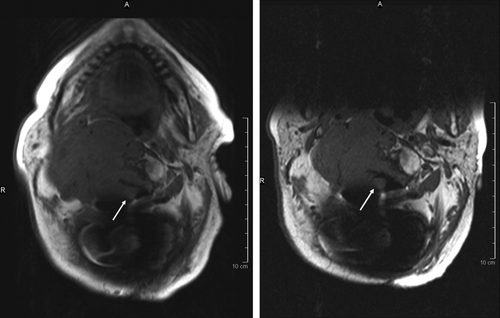To the Editor
A previously healthy woman born in 1932 presented in 1996 with a chordoma of the second cervical vertebra, dislocating the spinal cord. She underwent laminectomy and occipitocervical fixation. She received radiotherapy at a dose of 50 Gy in 28 fractions. In February 2006 and April 2007 she was reoperated due to deteriorating ability to walk.
The second operation did not bring about any improvement, and in August 2007 her condition worsened with incontinence, increasing right-sided weakness and her right hand became completely useless. An MRI showed spinal cord compression and a 6.5×5.5 cm large right cervical mass.
Based on a case report of successful treatment of a patient with metastatic chordoma using cetuximab and gefitinib Citation[1], the decision was made to offer the patient treatment with these drugs. The patient was started on cetuximab weekly and gefitinib 250 mg daily. After a week she reported the return of continence and after two weeks she was able to walk using a walking frame and to use her right hand to cut while eating. At the 4-week check-up the therapy was temporally stopped due to facial acne. The therapy was resumed a couple of weeks later and after 4 month of treatment an MRI scan showed regression of the spinal cord compression and the tumour had shrunk to 4.9×4.1 cm (see ).
Discussion
The standard treatment for chordoma is surgery and radiotherapy. There is no recognised effective chemotherapy. The above cited case using two different agents to target the epidermal growth factor receptor, EGFR Citation[1], was considered to provide a basis for offering our patient the same treatment Citation[2]. The present case shows that neurological function may return with the regression of spinal cord compression, using targeting drugs. The fast return of function may be related to the way in which targeting drugs work. Unlike radiotherapy which, to a large extent, relies on post-mitotic apoptosis and may thus allow the tumour to grow before it shrinks Citation[3], targeting drugs induce apoptosis in tumour cells Citation[2] without their going through mitosis. Furthermore, since radiotherapy is fractionated a tumour may grow until a sufficient dose to halt it has been absorbed. Minimal tumour growth is usually of no importance in settings where neurological function is not compromised, however, when it is, an extra mm in tumour size may be extremely undesirable. Targeted therapy is thus theoretically an attractive option when neural function is compromised. This observation may encourage research into targeted drugs in spinal cord compression due not only to chordoma, but more widely, as indicated by a report of renal cell carcinoma Citation[4].
References
- Hof H, Welzel T, Debus J. Effectiveness of cetuximab/gefitinib in the therapy of a sacral chordoma. Onkologie 2006; 29: 572–4
- Huang S, Armstrong EA, Benavente S, Chinnaiyan P, Harari PM. Dual-agent molecular targeting of the epidermal growth factor receptor (EGFR): Combining anti-EGFR antibody with tyrosine kinase inhibitor. Cancer Res 2004; 64: 5355–62
- Thomlinson RH. Measurement and management of carcinoma of the breast. Clin Radiol 1982; 33: 481–93
- Trinh QD, Cardinal E, Gallina A, Perrotte P, Saad F, Karakiewicz PI. Sunitinib relieves renal cell carcinoma spinal cord compression. Eur Urol 2007; 51: 1741–3

